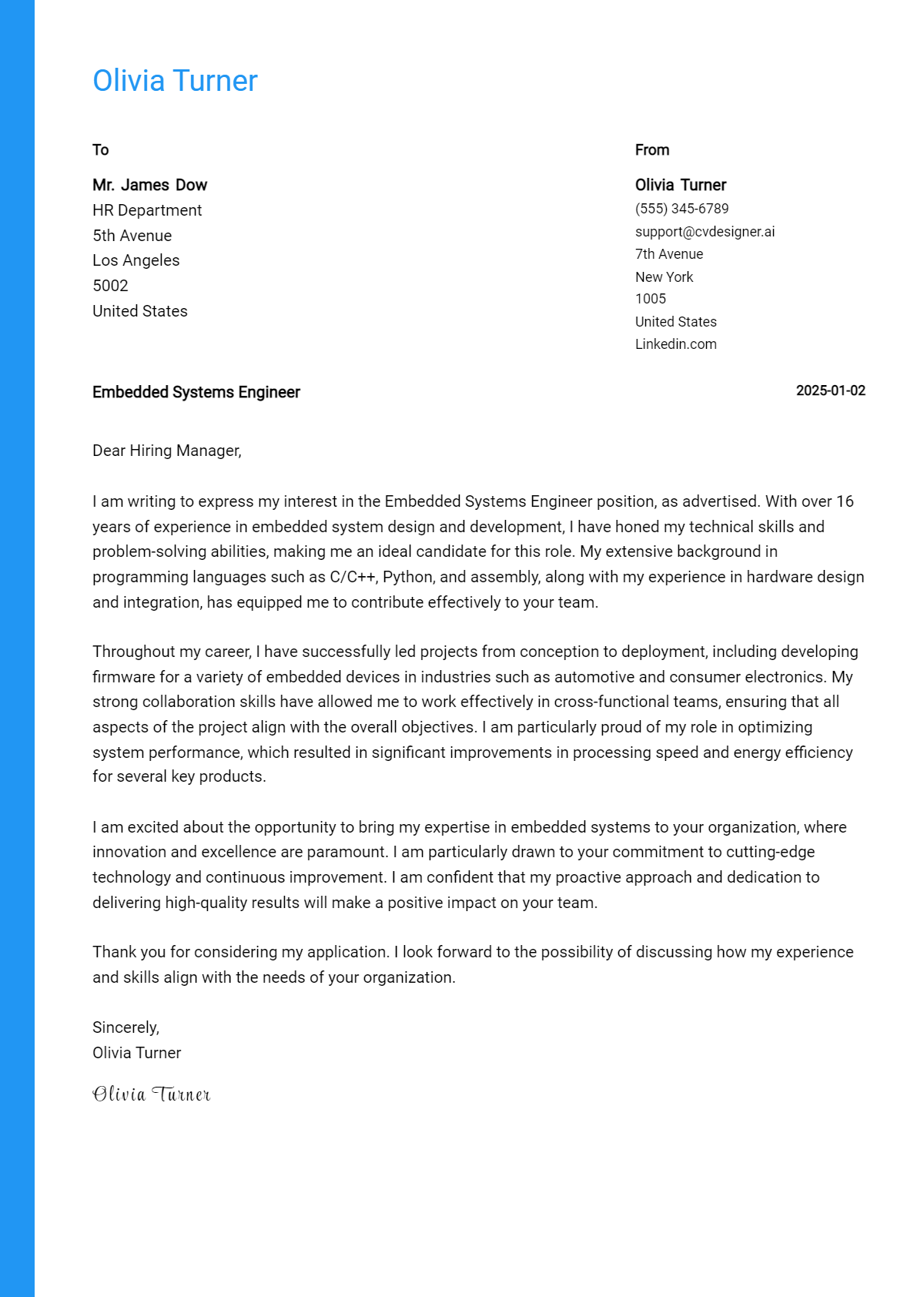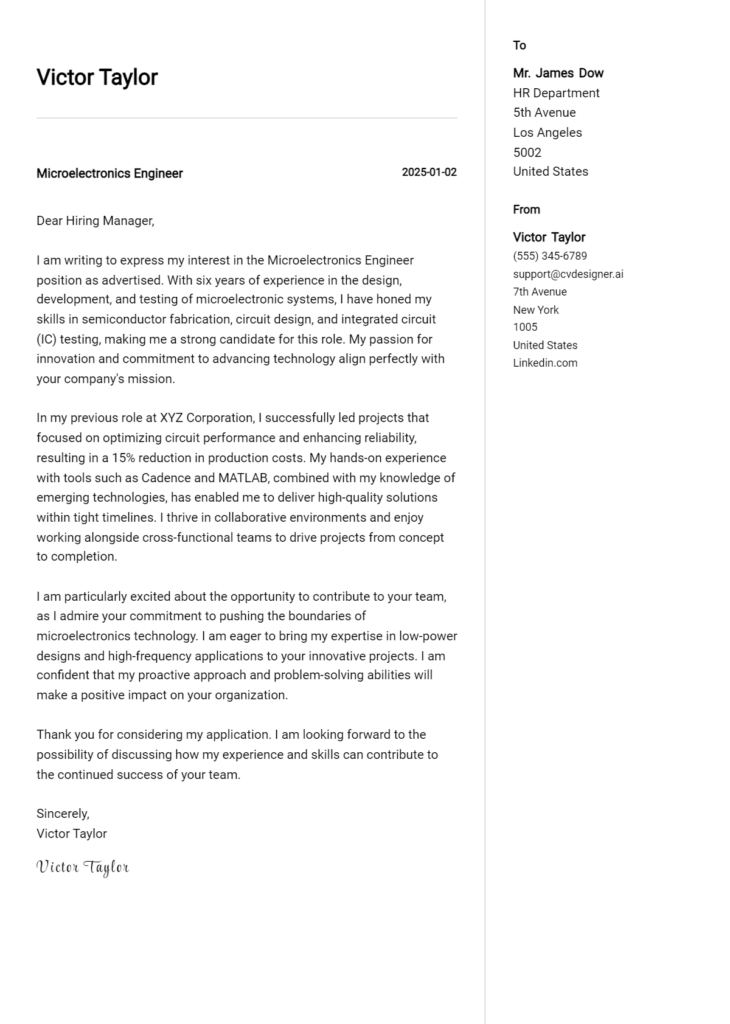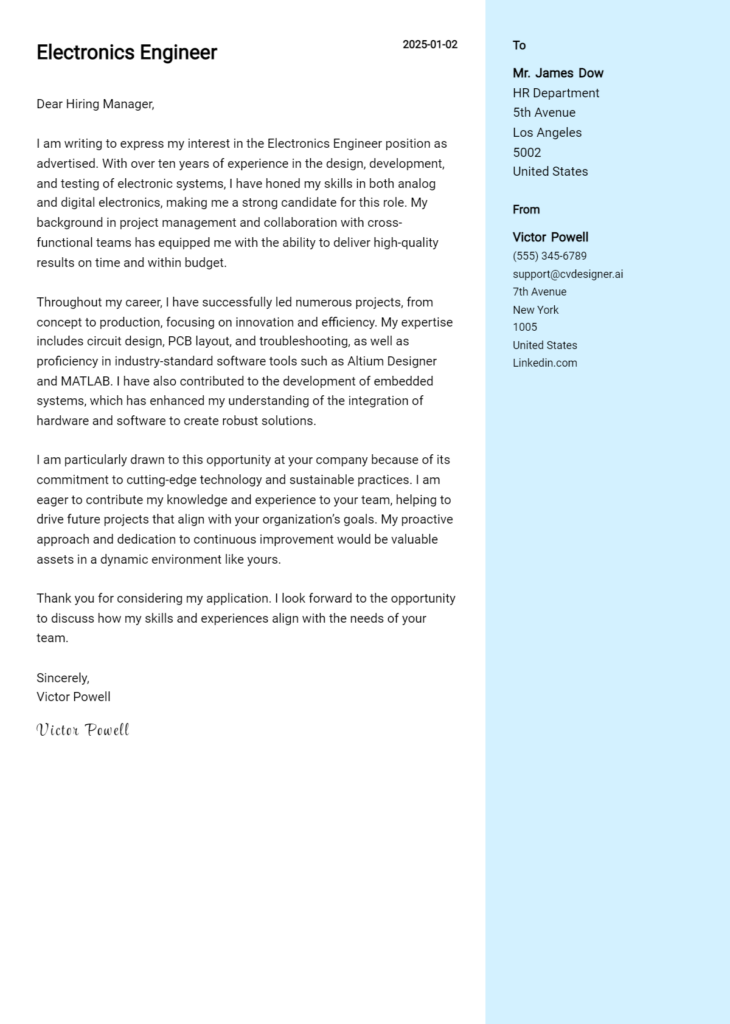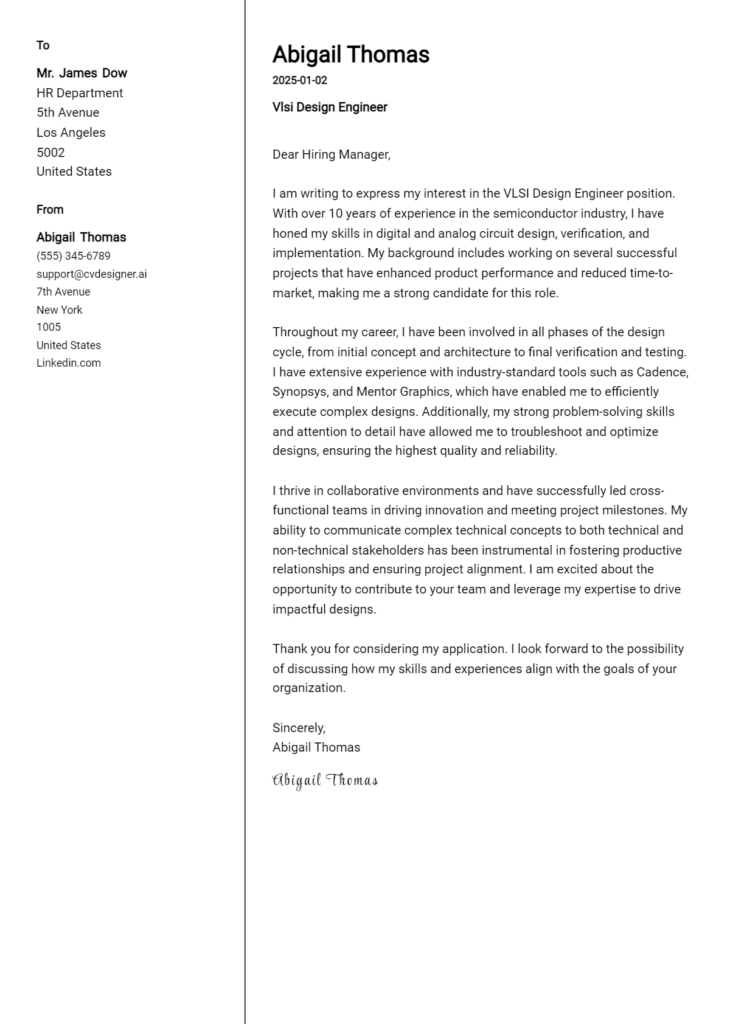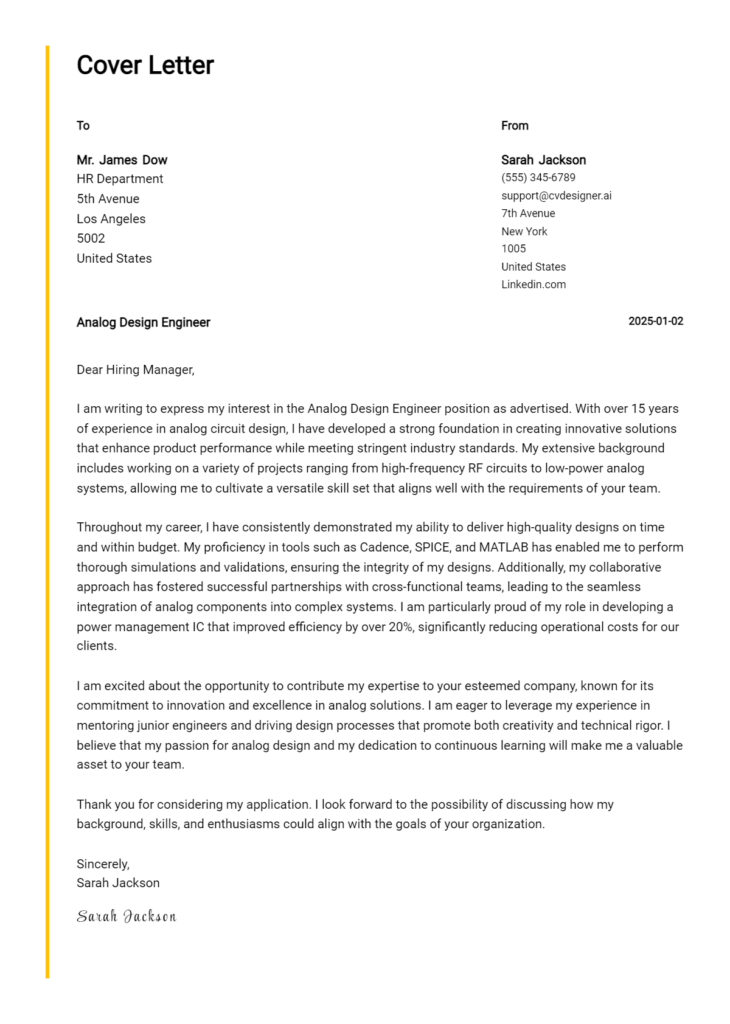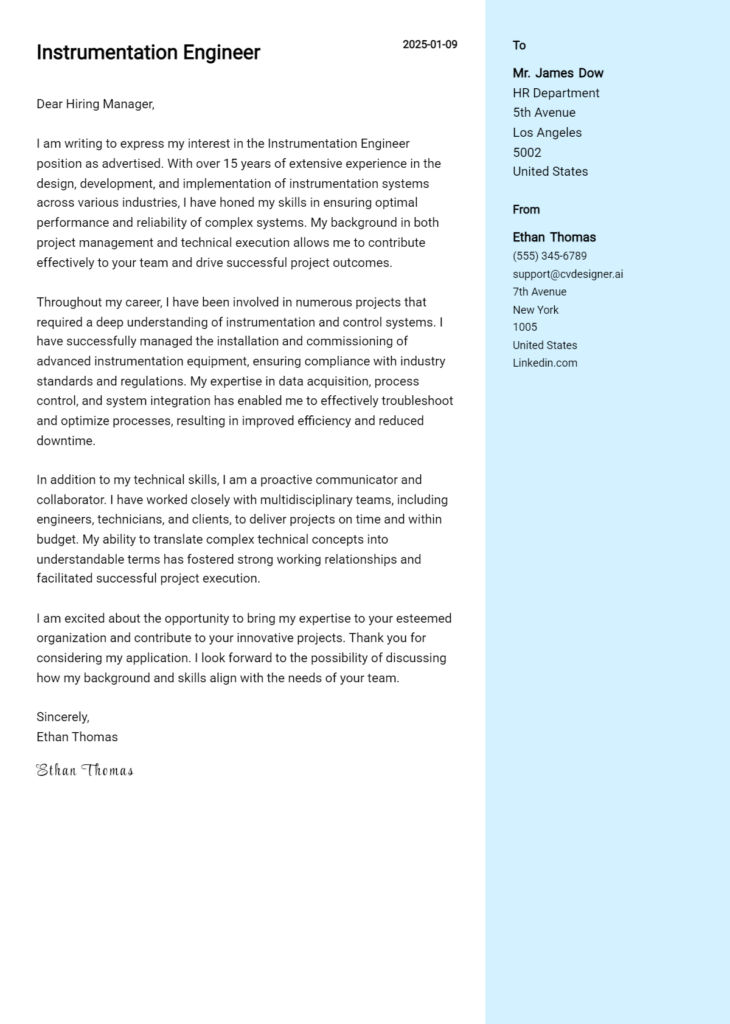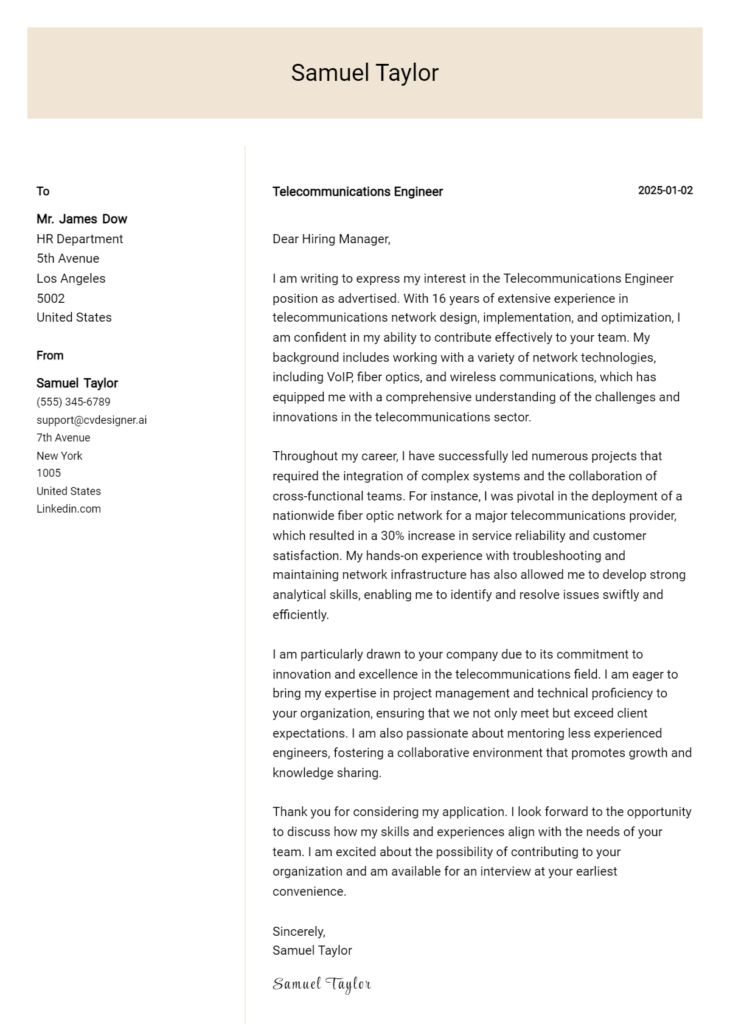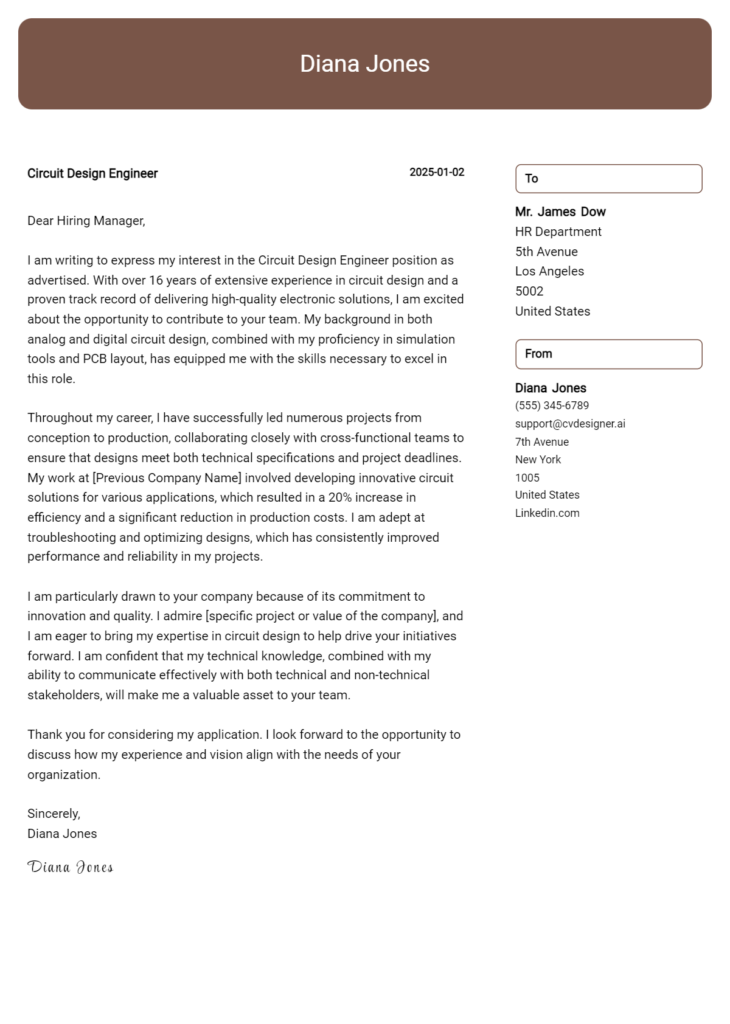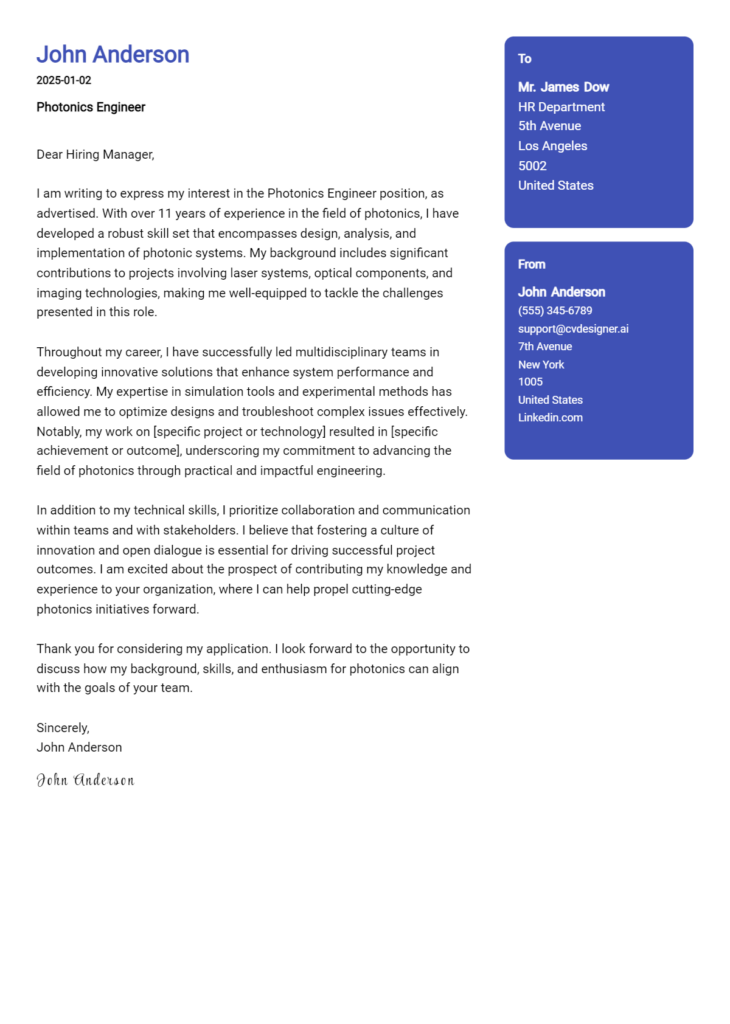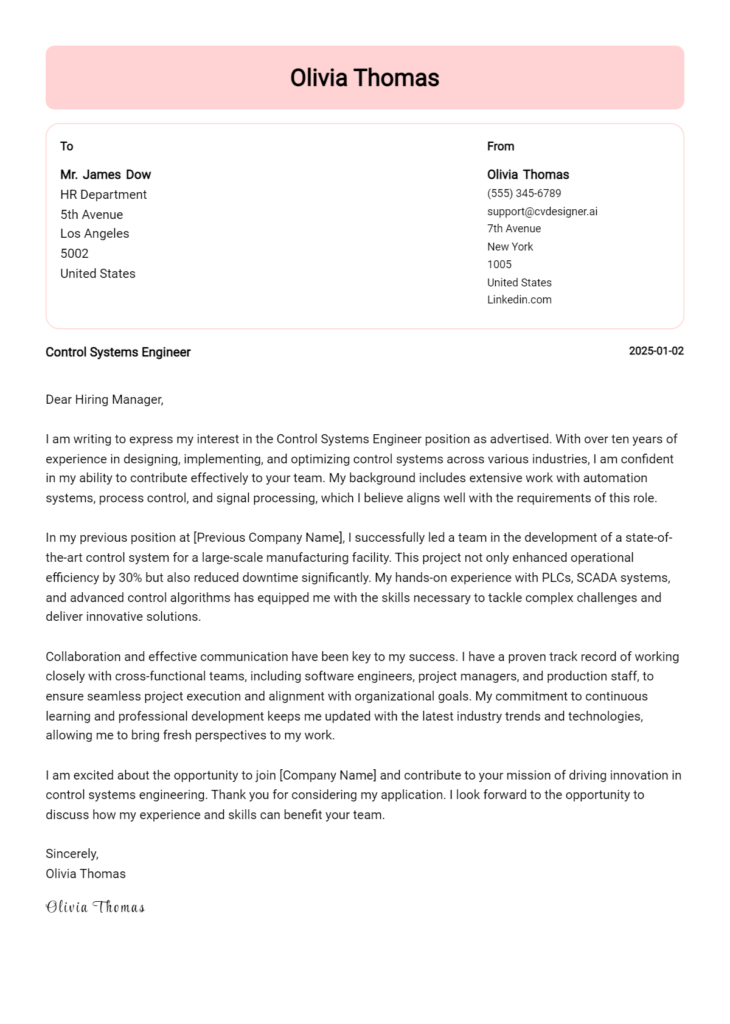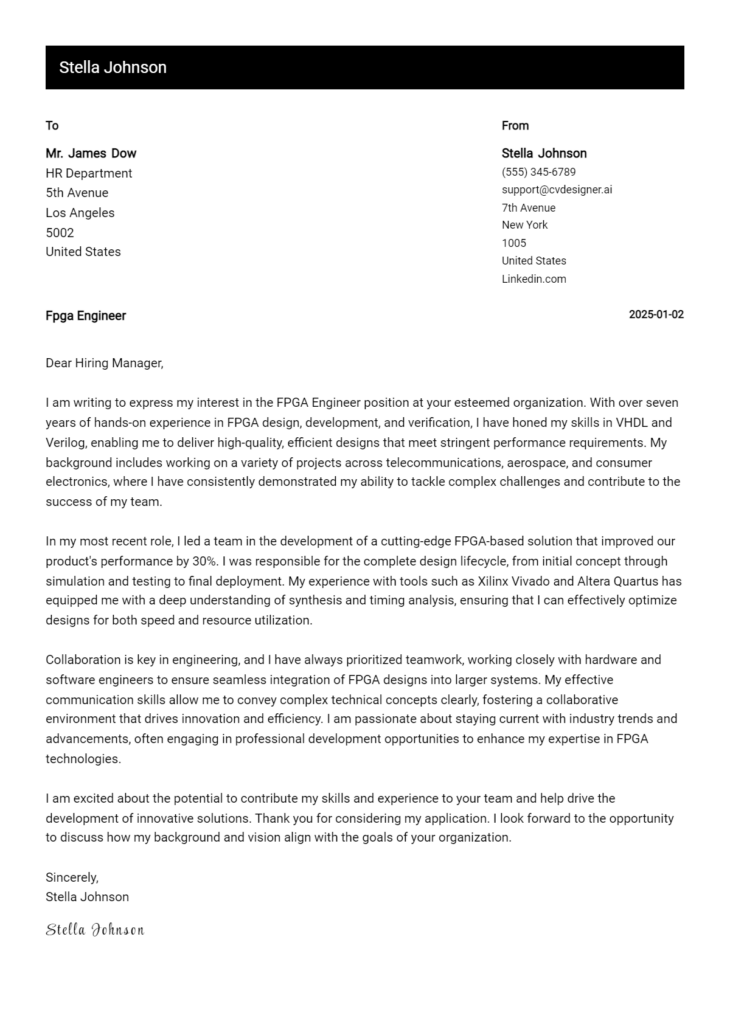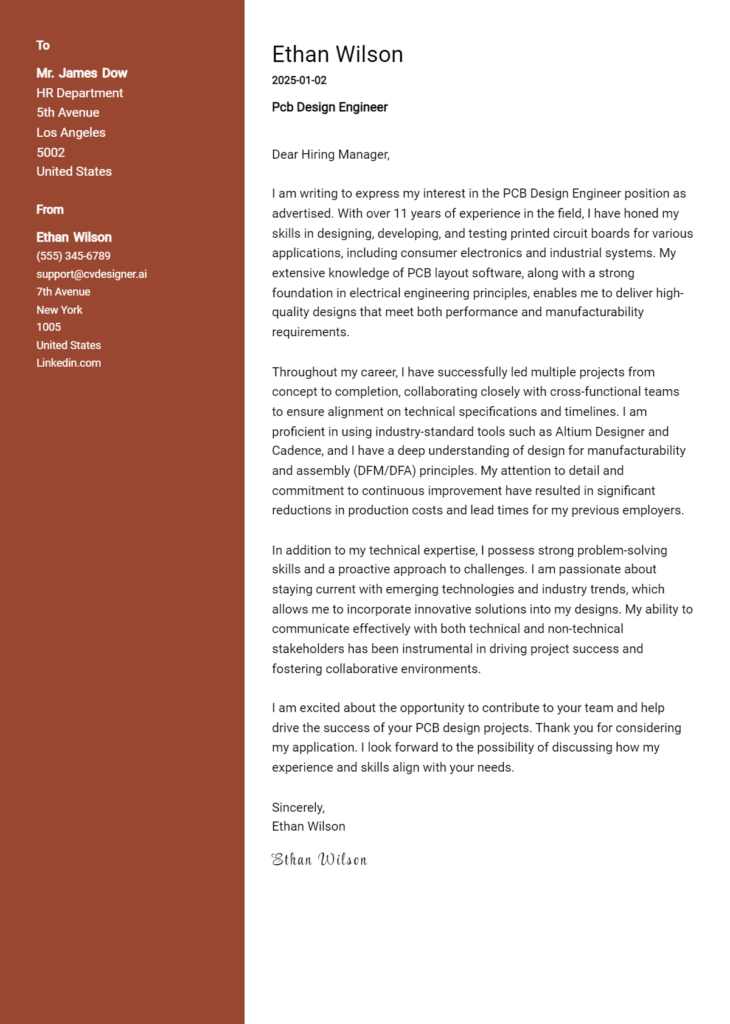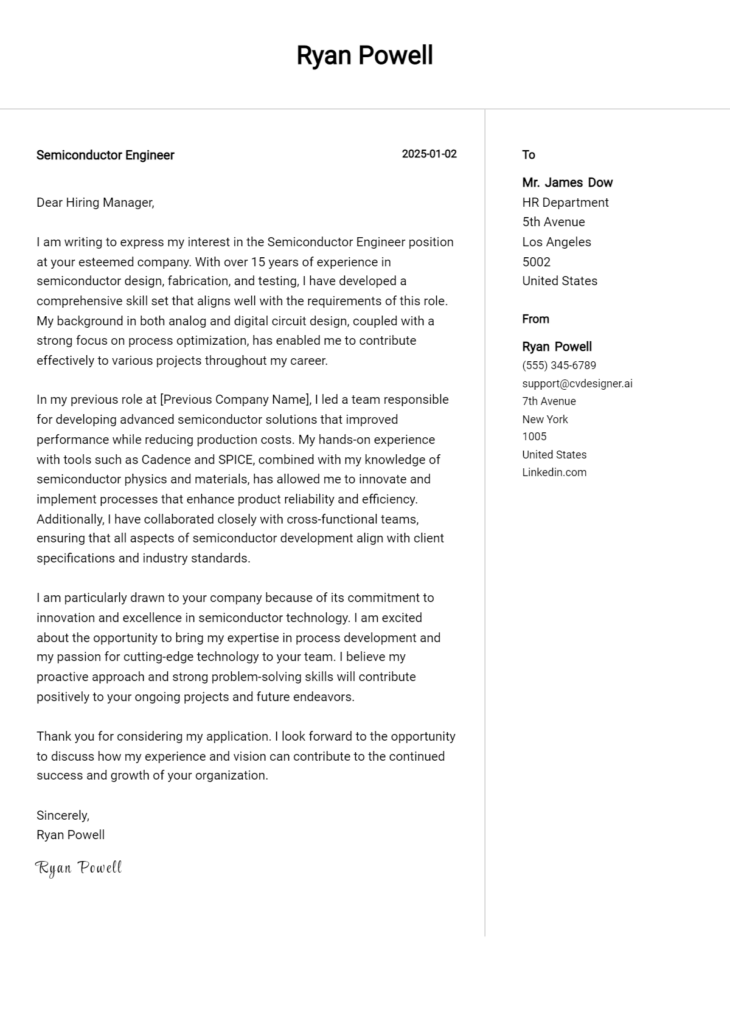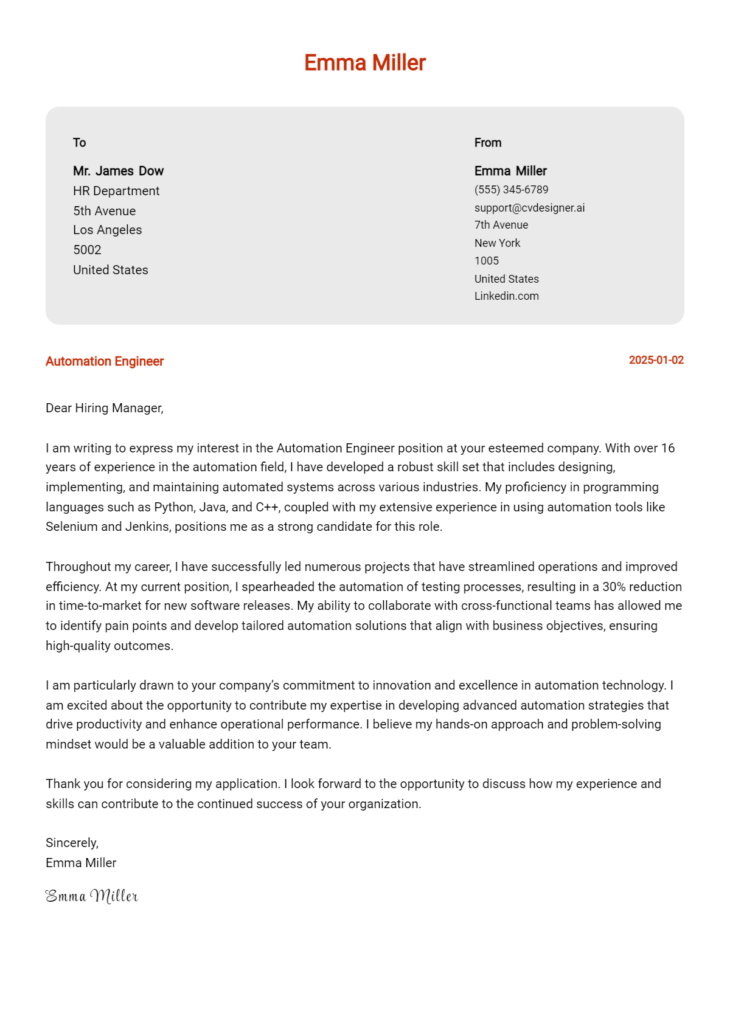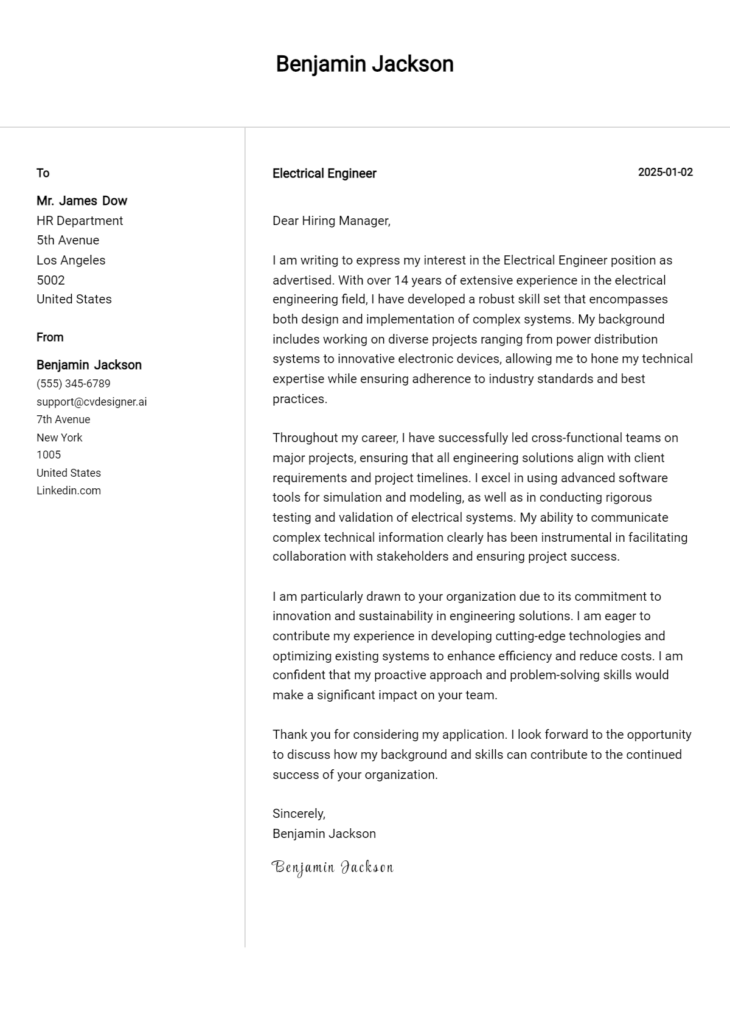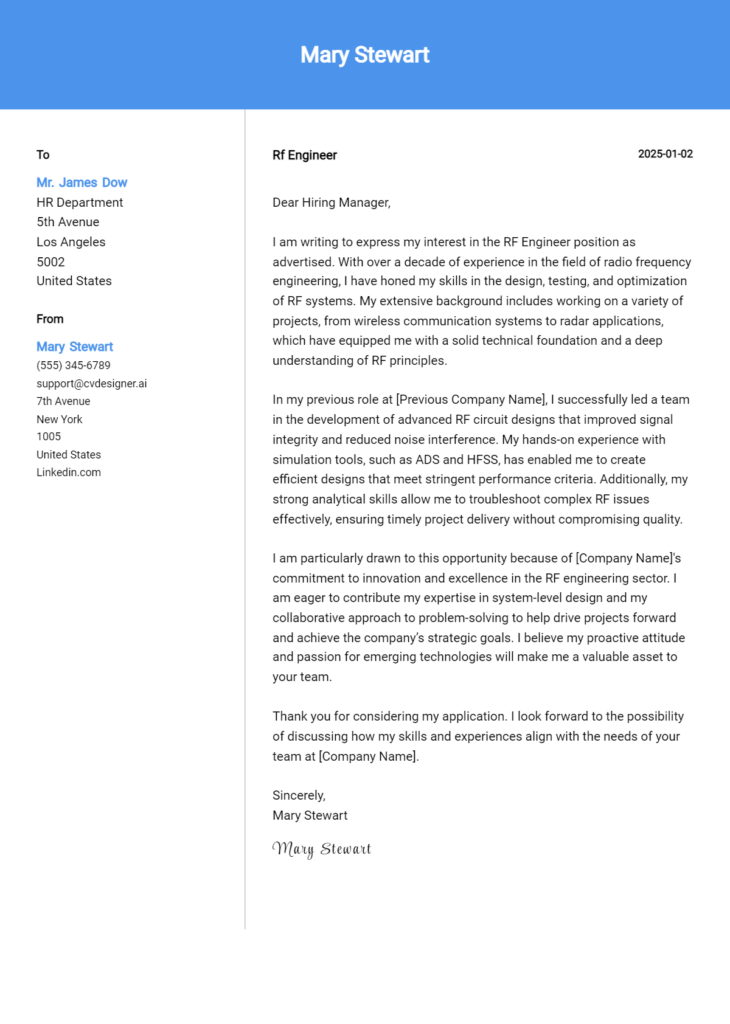Embedded Systems Engineer Cover Letter Examples
Explore additional Embedded Systems Engineer cover letter samples and guides and see what works for your level of experience or role.
How to Format an Embedded Systems Engineer Cover Letter?
Crafting an effective cover letter is essential for an Embedded Systems Engineer, as it not only showcases your technical expertise but also reflects your ability to communicate complex ideas clearly. The format of your cover letter is crucial; it serves as a first impression that highlights your attention to detail and organizational skills—both of which are vital in the embedded systems field. A well-structured cover letter can capture the hiring manager's attention and effectively convey your suitability for the role.
In this guide, we'll outline the key components of a professional cover letter, focusing on:
- Cover Letter Header
- Cover Letter Greeting
- Cover Letter Introduction
- Cover Letter Body
- Cover Letter Closing
Each section is integral to presenting your qualifications and professionalism. Let’s break down each part to help your Embedded Systems Engineer cover letter stand out.
Importance of the Cover Letter Header for an Embedded Systems Engineer
The cover letter header is a crucial component that sets the tone for the entire application. It serves as the first point of contact between the applicant and the potential employer, making clarity and professionalism paramount. A well-structured header not only conveys essential information but also reflects the applicant's attention to detail and organizational skills—qualities that are vital for an Embedded Systems Engineer. The header should include the applicant's contact information, the date, and the recipient's details, ensuring that all parties have the necessary information to proceed with the application process.
A strong header creates a professional impression, while a weak one can detract from the applicant's credibility. Below are examples of a strong and weak cover letter header for an Embedded Systems Engineer.
Strong Example
John Doe 1234 Tech Lane Engineering City, CA 90210 john.doe@email.com (123) 456-7890 [Date] Hiring Manager Innovative Tech Solutions 5678 Industry Ave Tech Town, CA 90211
Weak Example
John D. Email: john.doe@email.com 12/01/2023 To whom it may concern:
The Importance of the Cover Letter Greeting
The greeting of your cover letter is more than just a formality; it sets the tone for the entire letter and serves as your first impression on the hiring manager. A well-crafted greeting demonstrates professionalism and shows that you have taken the time to personalize your application. Addressing the hiring manager directly can create a connection and highlight your attention to detail. To avoid generic greetings like "To whom it may concern," it's essential to research the recipient's name, which can often be found on the company website or through LinkedIn. A personalized greeting not only reflects your genuine interest in the position but also distinguishes you from other candidates.
Strong Greeting Example
Dear Dr. Smith,
Weak Greeting Example
To whom it may concern,
Cover Letter Introduction for Embedded Systems Engineer
A well-crafted cover letter introduction is crucial for any Embedded Systems Engineer looking to make a positive impression on a hiring manager. This introductory paragraph should not only capture the reader's attention but also clearly express the candidate's enthusiasm for the role. It serves as a snapshot of the applicant's qualifications, providing a brief glimpse into their key skills or notable achievements. A strong introduction can set the tone for the rest of the cover letter, making the applicant stand out in a competitive field, while a weak introduction may lead to an unremarkable first impression that fails to entice the reader to continue.
Strong Example
Dear [Hiring Manager's Name], I am excited to apply for the Embedded Systems Engineer position at [Company Name]. With over five years of experience in developing high-performance embedded systems for automotive applications, I have honed my skills in C/C++ programming, hardware-software integration, and real-time operating systems. My recent project, which involved designing a safety-critical control system for electric vehicles, not only enhanced my technical expertise but also deepened my passion for creating innovative solutions that drive technological advancement. I am eager to bring my skills and dedication to your team at [Company Name].
Weak Example
To Whom It May Concern, I am writing to apply for the Embedded Systems Engineer role at your company. I have done some work in embedded systems, and I think I could do a good job. I have experience with various programming languages and some projects under my belt, so I hope you consider my application.
Purpose of the Cover Letter Body for an Embedded Systems Engineer
The body of a cover letter for an Embedded Systems Engineer serves as a critical opportunity for candidates to effectively showcase their technical skills, relevant experiences, and overall value to a potential employer. This section allows candidates to highlight specific projects or accomplishments that demonstrate their expertise in areas such as software development, hardware integration, and system design. By detailing their contributions to past projects—whether through successful implementation of complex algorithms or the optimization of existing systems—candidates can illustrate how their background aligns with the needs of the company. A well-crafted cover letter body not only reflects the candidate’s qualifications but also communicates their enthusiasm for the position and the unique value they bring to the team.
Strong Example
Dear Hiring Manager, I am excited to apply for the Embedded Systems Engineer position at XYZ Corp. In my previous role at ABC Technologies, I led a team in the development of a real-time embedded system for a medical device, which improved patient monitoring accuracy by 30%. My expertise in C and C++ programming, coupled with my experience in hardware-software integration, allowed us to successfully reduce the system's response time from 200ms to 50ms. Additionally, I implemented a rigorous testing protocol that decreased software bugs by 40% before deployment. I am eager to bring my technical skills and hands-on experience to your innovative team, particularly in developing next-generation IoT solutions. Sincerely, John Doe
Weak Example
Dear Hiring Manager, I am writing to apply for the Embedded Systems Engineer position. I have worked on several projects involving embedded systems, and I believe I can contribute to your company. I have experience in programming and have worked with microcontrollers. My previous job involved some testing and debugging of systems. I am interested in the role and hope to work at your company. Best, John Doe
Importance of the Cover Letter Closing for an Embedded Systems Engineer
The closing paragraph of a cover letter is crucial as it serves to summarize your qualifications, reiterate your enthusiasm for the role, and prompt the hiring manager to take the next steps, such as reviewing your resume or scheduling an interview. A strong closing can leave a lasting impression, reinforcing your suitability for the position and your eagerness to contribute to the team. In contrast, a weak closing may fail to convey your interest or professionalism, potentially diminishing your chances of moving forward in the hiring process.
Strong Example
Thank you for considering my application for the Embedded Systems Engineer position. With my solid foundation in software and hardware integration, along with my passion for innovative technology solutions, I am excited about the opportunity to contribute to your team. I look forward to the possibility of discussing how my skills align with your needs and would be eager to provide any additional information during an interview. Please feel free to contact me at your convenience to schedule a discussion.
Weak Example
Thanks for reading my letter. I hope you like my resume. If you want to talk, you can call me or email me. I'm okay with whatever you decide.
These tips are designed to help candidates craft an effective cover letter for the role of an Embedded Systems Engineer. A well-written cover letter can set you apart in a competitive job market, showcasing your technical skills, problem-solving abilities, knowledge of the Software Development Life Cycle (SDLC), teamwork experience, and a passion for continuous learning. By focusing on these areas, you can create a compelling narrative that resonates with potential employers.
Tips for Crafting an Effective Cover Letter
Highlight Your Technical Skills: Clearly outline your technical prowess in areas such as microcontroller programming, real-time operating systems (RTOS), and hardware-software integration. Use specific examples of projects where you applied these skills, demonstrating your ability to handle the complexities of embedded systems.
Showcase Problem-Solving Abilities: Employers value engineers who can think critically and solve problems efficiently. Share a brief story or example where you identified a challenge in an embedded system project and how you approached it, emphasizing your analytical thinking and resolution process.
Demonstrate SDLC Knowledge: Understanding the Software Development Life Cycle is crucial for an Embedded Systems Engineer. Mention your familiarity with various phases of SDLC, including requirements gathering, design, coding, testing, and maintenance. Discuss how your experience aligns with these phases in past projects.
Emphasize Teamwork and Collaboration: Embedded systems projects often require collaboration with cross-functional teams. Highlight your experiences working with hardware engineers, software developers, and quality assurance teams. Illustrate how your teamwork led to successful project outcomes, showcasing your communication and interpersonal skills.
Express Passion for Continuous Learning: The field of embedded systems is constantly evolving. Convey your enthusiasm for staying updated with the latest technologies, tools, and methodologies. Mention any relevant certifications, online courses, or workshops you have undertaken. This shows potential employers that you are committed to personal and professional growth.
For further assistance, consider using our cover letter templates and cover letter builder to create a professional and tailored cover letter that reflects your unique qualifications and experiences.
Common Mistakes to Avoid in an Embedded Systems Engineer Cover Letter
Crafting an effective cover letter is essential for standing out as an Embedded Systems Engineer. Avoiding common mistakes can significantly enhance your chances of getting noticed by recruiters. Here are some frequent pitfalls and tips on how to steer clear of them:
Generic Content: Using a one-size-fits-all approach can make your cover letter feel impersonal. Tailor your letter to the specific job and company by highlighting relevant skills and experiences.
Ignoring the Format: Failing to adhere to a professional format can detract from your credibility. For guidance on proper structure, refer to this cover letter format.
Lack of Technical Detail: As an Embedded Systems Engineer, it’s crucial to demonstrate your technical expertise. Include specific technologies, programming languages, or methodologies you have experience with.
Overly Lengthy Letters: Recruiters often skim cover letters, so keep yours concise. Aim for one page, focusing on the most relevant information.
Neglecting to Proofread: Spelling and grammatical errors can undermine your professionalism. Always proofread your letter and consider having a peer review it as well.
Focusing Solely on Skills: While it’s important to showcase your qualifications, also convey your enthusiasm for the role and the company. Share what excites you about the opportunity.
Failing to Include a Call to Action: Conclude your cover letter with a strong call to action, expressing a desire for an interview or further discussion. This shows initiative and eagerness.
For more inspiration, check out these cover letter examples that can guide you in crafting a compelling narrative. By avoiding these common mistakes, you can create a standout cover letter that effectively showcases your qualifications as an Embedded Systems Engineer.
Cover Letter FAQs for Embedded Systems Engineer
What should I include in my cover letter as an Embedded Systems Engineer?
When writing your cover letter as an Embedded Systems Engineer, you should include your relevant education, technical skills, and specific experiences that relate to the job posting. Highlight your proficiency in programming languages such as C, C++, or Python, and mention any experience with real-time operating systems or microcontrollers. Discuss any notable projects you’ve worked on, emphasizing your problem-solving skills and your ability to work in a team. Additionally, convey your passion for embedded systems and your understanding of the company’s products or services, showcasing how you can contribute to their success. Finally, ensure to conclude with a strong statement expressing your eagerness for an interview.
How can I tailor my cover letter for a specific job?
To tailor your cover letter for a specific Embedded Systems Engineer position, start by carefully reading the job description and identifying key requirements and responsibilities. Use this information to align your skills, experiences, and achievements with the job's needs. For example, if the job emphasizes expertise in IoT, discuss your relevant experience with IoT devices and protocols. Additionally, mention the company's projects or values to show your genuine interest. Avoid generic phrases and focus on specifics that resonate with the job role. Ultimately, customizing your cover letter demonstrates your commitment to the position and helps you stand out as a candidate.
How long should my cover letter be?
Your cover letter should ideally be one page, consisting of three to four paragraphs that succinctly convey your qualifications and enthusiasm for the Embedded Systems Engineer position. Aim for a length of 250 to 400 words, ensuring that you keep your writing concise and focused. Use the first paragraph to introduce yourself and state the position you are applying for, followed by a middle section that elaborates on your relevant experience and skills. In the conclusion, express your eagerness for the role and a desire to discuss your qualifications in more detail during an interview. Keeping it brief yet impactful will leave a positive impression.
What tone should I use in my cover letter?
In your cover letter for an Embedded Systems Engineer position, maintain a professional yet approachable tone. Use clear and concise language that reflects your technical expertise while ensuring it remains accessible to a broader audience. Avoid overly technical jargon unless it is relevant to the role and company culture. Your tone should convey confidence and enthusiasm about the position without being overly casual. Expressing genuine interest in the company and the role, along with a respectful acknowledgment of their work, can help create a positive connection. Ultimately, the goal is to strike a balance that showcases your professionalism while also allowing your personality to shine through.
Build your Cover Letter in minutes
Use an AI-powered cover letter builder and have your letter done in 5 minutes. Just select your template and our software will guide you through the process.

